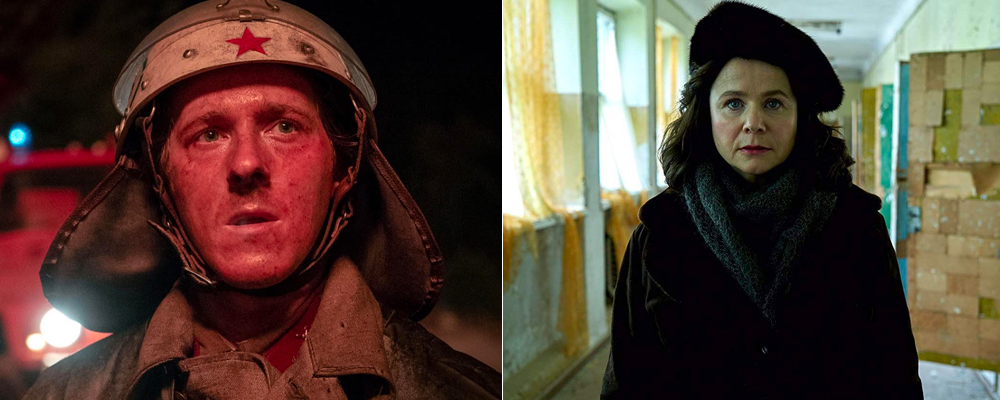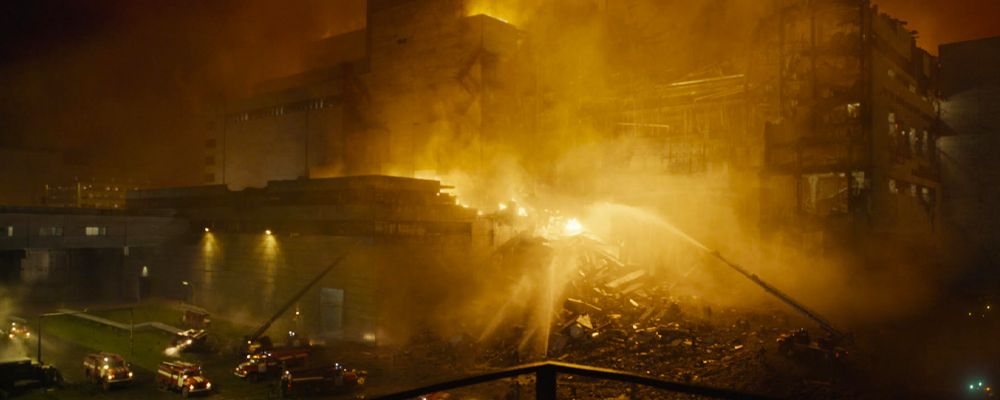HBO’s ‘Chernobyl’ Intensely Chronicles History’s Worst Nuclear Disaster
Alci Rengifo
HBO’s new miniseries “Chernobyl” chronicles a real life apocalypse. Early in the morning on April 26, 1986 a nuclear power station in the Soviet Union exploded, emitting deadly radiation into the air and forever defining the potentials for atomic catastrophe. It is a classic tale of immense tragedy caused by human folly, told with a vision that borders on dystopia. These five episodes are more terrifying than any Hollywood disaster thriller, because the horror story being told is real and the effects still linger.
We begin on a fateful night as a young wife, Lyudmilla Ignatenko (Jessie Buckley), wakes up in the rural town of Pripyat in the former Soviet Ukraine and sees a massive explosion out her window. Cut to the Chernobyl nuclear power plant where the explosion sends engineers who had been conducting a test, scrambling to get answers. But even after it becomes obvious a serious accident has occurred and the plant’s core is exposed, deputy chief engineer Anatoly Dyatlov (Paul Ritter) refuses to admit it, issuing orders to move reactor rods which don’t exist anymore, and dismissing signs workers are becoming ill with radiation sickness. Dyatlov’s bosses, plant directors Viktor Bryukhanov (Con O’Neill) and Nicolai Fomin (Adrian Rawlins) also refuse to admit the obvious out of fear of feeling the wrath of their Communist Party superiors. Meanwhile Lydumilla’s husband Vasily (Adam Nagaitis) is part of the fire brigade sent to put out the raging firestorm at the plant, unknowingly walking into a radiated trap. It soon becomes too obvious this is a serious matter and Soviet premiere Mikhail Gorbachev (David Dencik) sends Deputy Prime Minister Boris Shcherbina (Stellan Skarsgård) and nuclear physicist Valery Legasov (Jared Harris) to tackle the crisis. But once they arrive at Chernobyl, it becomes terrifyingly clear to Legasov that this is a cataclysm sending endless radiation into the air and environment, threatening to soon spread across Europe. A race against time ensues to avert a total meltdown and all of Pripyat is evacuated. Another scientist, Ulana Khomyuk (Emily Watson), also arrives to get answers as to how this could have happened.
Before taking a look at the highly relevant, even political significance of this story, “Chernobyl” first succeeds as an absolutely visceral experience. Every episode is directed by Johan Renck and written by producer Craig Mazin. These are not two names we readily associate with serious nonfiction-based drama. Renck’s credits include work on “The Walking Dead” and David Bowie’s final, haunting music videos for the songs “Dark Star” and “Lazarus.” Mazin’s writing credits include “The Hangover Part II” and “Identity Thief.” And yet here they are, crafting a brilliant blow by blow dramatization of what happened in Chernobyl, finding riveting drama in the facts. Even if you have heard the basic details of the tragedy before, never has it been presented like this. Renck films the burning power plant like a menacing nuclear furnace. Workers peer at the burning core, taking in blasts of radiation. Children walk to school in the nearby city, exiting the frame as on an empty sidewalk a dying bird suddenly falls from the sky. Visuals like these are eerily dystopian, like scenes of men in gas masks and anti-contamination suits walking down the empty streets of Pripyat, or venturing underground to swim in radioactive water to carry out necessary work and avert a greater tragedy. Scenes have a quiet horror to them, like a moment where a plant worker is ordered by Dyatlov to venture out into the roof to see for himself that nothing is wrong. What he finds is a massive crater shooting radioactive smoke into the air. He slowly ventures towards toxic cloud, then turns to face us with skin now turning red.
The miniseries has the pace of a thriller, but a tragically human one. Renck and Mazin give different angles of the story enough space to capture the vast scope of what happened. Shcherbina and Legasov arrive to Chernobyl to contain the crisis while being mindful of the USSR’s obsession with secrecy and propaganda. Shcherbina is a man of the party, at first bullheaded about listening to Legasov, going so far as to order a pilot to fly over the power plant to truly see if the roof has blown open. It is Legasov who has to school him on the sober realities of what’s at stake, bluntly informing him that Chernobyl is emitting about twice the radiation of the Hiroshima bomb every hour into the atmosphere. These men were tasked with a crisis the world simply hadn’t dealt with before. Consider the human cost itself. When robotic equipment can’t clear debris off the plant’s roof because of radioactivity, soldiers are sent for 90 second shifts. Legasov warns a befuddled Gorbachev that each of these operations guarantees the men involved will probably die. This includes miners brought from distant Soviet territories to dig underneath the plant to prevent a radioactive meltdown that will certainly poison major water supplies. Even military helicopters struggle with pouring sand over the exposed core, lest their circuitry be shattered by radioactive waves. Cinematographer Jakob Ihre captures all of this with a saturated, baroque style that brings to mind films like Andrei Tarkovsky’s “Stalker.” The radiation itself becomes a silent, invisible monster, only detectable through the crackle of a Geiger counter. A brilliantly-conceived moment atop the plant’s roof, where soldiers are scooping up debris, is set to the rising and falling Geiger sound.
The accident’s human cost is told through the story of Lyudmilla and Vasily. He and the other firemen are taken to the hospital, but once the effects of radiation manifest we are witness to its gruesome cruelty. Lyudmilla will sit next to her husband, even as his skin dissolves and face disappears, unaware of the danger to herself. The dead will be buried in steel caskets, covered in concrete. Dying plant workers will tell what they know to Ulana Khomyuk, leaving a damning testimonial to her as they slip away in agony.
“Chernobyl” becomes in its final moments an urgent meditation on humanity’s attempts to control nature and then sleepwalking into catastrophe because of our own arrogance. As Ulana and Legasov try to get answers the KGB keeps a close eye, and when it becomes apparent flaws in the very safety system of the plant led ironically to the accident, their very careers are in danger. The Stalinist system was so rigid that even in the first moments of the accident, Dyatlov, Bryukhanov and Fomin insist to local officials that all is fine. It’s astonishing how even a vomiting engineer only inspires absurd denials. This is a world where just telling the truth is a heroic act. Yet “Chernobyl” is not merely an indictment of the Soviet system in the 1980s, but a relevant story in a time when politicians and bureaucrats of any persuasion will deny emerging threats, such as climate change.
The closing scenes of this brilliant miniseries inform us that the area around Chernobyl remains contaminated, with a new covering put over the plant’s damaged core designed to last 100 years. For the “exclusion zone” around Chernobyl to ever be truly habitable again will take even longer, possibly centuries. We won’t ever truly know just how many people died as a result of exposure to the toxic cloud the plant unleashed. “Chernobyl” tells a haunting nightmare that speaks to us still. It seems to ask if we’re always doomed to act only when it’s too late.
“Chernobyl” premieres May 6 and airs Mondays at 9 p.m. ET on HBO.






